User:Ogbumegmt/sandbox

The culture of Africa Nations is varied and manifold. It is a product of the diverse populations that today inhabit the continent of Africa and the African Diaspora. Like much of the world, it has been impacted upon by both internal and external forces.[1]
Historical overview
[edit]
Africa is divided into a great number of ethnic cultures.[2][3][4] The continent's cultural regeneration has also been an integral aspect of post-independence nation-building on the continent, with a recognition of the need to harness the cultural resources of Africa to enrich the process of education, requiring the creation of an enabling environment in a number of ways. In recent times, the call for a much greater emphasis on the cultural dimension in all aspects of development has become increasingly vocal.[5] During colonialism in Africa, Europeans possessed attitudes of superiority and a sense of mission. The French were able to accept an African as French if that person gave up their African culture and adopted French ways. Knowledge of the Portuguese language and culture and abandonment of traditional African ways defined one as civilized.[6] Kenyan social commentator Mwiti Mugambi argues that the future of Africa can only be forged from accepting and mending the sociocultural present. For Mugambi, colonial cultural hangovers, pervasive Western cultural inundation, and aid-giving arm-twisting donors are, he argues, here to stay and no amount of looking into Africa's past will make them go away. However, Maulana Karenga states:
Our culture provides us with an ethos we must honor in both thought and practice. By ethos, we mean a people's self-understanding as well as its self-presentation in the world through its thought and practice in the other six areas of culture. It is above all a cultural challenge. For culture is here defined as the totality of thought and practice by which a people creates itself, celebrates, sustains and develops itself and introduces itself to history and humanity
— Maulana Karenga, African Culture and the Ongoing Quest for Excellence[7]
African arts and crafts
[edit]
Africa has a rich tradition of arts and crafts. African arts and crafts find expression in a variety of woodcarvings, brass and leather art works. African arts and crafts also include sculpture, paintings, pottery, ceremonial and religious headgear and dress. Maulana Karenga states that in African art, the object was not as important as the soul force behind the creation of the object. He also states that All art must be revolutionary and in being revolutionary it must be collective, committing, and functional, this is echoed by Shahadah who states "in Africa all art is socially functional."[1][8]
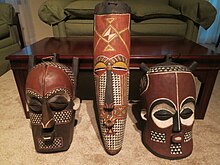
African culture has always placed emphasis on personal appearance and jewelry has remained an important personal accessory. Many pieces of such jewelry are made of cowry shells and similar materials. Similarly, masks are made with elaborate designs and are important part of African culture. Masks are used in various ceremonies depicting ancestors and spirits, mythological characters and deities.
In most of traditional art and craft of Africa, certain themes significant to African culture recur, including a couple, a woman with a child, a male with a weapon or animal, and an outsider or a stranger. Couples may represent ancestors, community founder, married couple or twins. The couple theme rarely exhibit intimacy of men and women. The mother with the child or children reveals intense desire of the African women to have children. The theme is also representative of mother mars and the people as her children. The man with the weapon or animal theme symbolizes honor and power. A stranger may be from some other tribe or someone from a different country, and more distorted portrayal of the stranger indicates proportionately greater gap from the stranger.
Folklore and religion
[edit]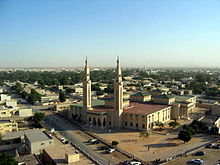
Like all human cultures, African folklore and religion represents a variety of social facets of the various cultures in Africa.[9] Like almost all civilizations and cultures, flood myths have been circulating in different parts of Africa. Culture and religion share space and are deeply intertwined in African cultures. In Ethiopia, Christianity and Islam form the core aspects of Ethiopian culture and inform dietary customs as well as rituals and rites.[1][10] According to a Pygmy myth, Chameleon, hearing a strange noise in a tree, cut open its trunk and water came out in a great flood that spread all over the land.
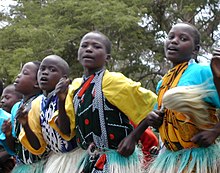
Folktales also play an important role in many African cultures. Stories reflect a group cultural identity and preserving the stories of Africa will help preserve an entire culture. Storytelling affirms pride and identity in a culture. In Africa, stories are created by and for the ethnic group telling them. Different ethnic groups in Africa have different rituals or ceremonies for storytelling, which creates a sense of belonging to a cultural group. To outsiders hearing an ethnic group's stories, it provides an insight into the community's beliefs, views, and customs. For people within the community, it allows them to encompass their group's uniqueness. They show the human desires and fears of a group, such as love, marriage, and death. Folktales are also seen as a tool for education and entertainment. They provide a way for children to understand the material and social environment. Every story has a moral to teach people, such as good will prevail over evil. For entertainment, stories are set in fantastic, non-human worlds. Often, the main character of the story would be a talking animal or something unnatural would happen to human character. Even though folktales are for entertainment, they bring a sense of belonging and pride to communities in Africa.[11]
There are different types of African stories: animal tales and day-to-day tales. Animal tales more oriented towards entertainment, but still have morals and lessons to them. Animal tales are normally divided into trickster tales and ogre tales. In the animal tales, a certain animal would always have the same character or role in each story so the audience does not have to worry about characterization. The Hare was always the trickster, clever and cunning, while the Hyena was always being tricked by the Hare. Ogres are always cruel, greedy monsters. The messengers in all the stories were the Birds. Day-to-Day tales are the most serious tales, never including humor, that explained the everyday life and struggles of an African community. These tales take on matters such as famine, escape from death, courtship, and family matters, using a song form when the climax of the story was being told.
African stories all have a certain structure to them. Villagers would gather around a common meeting place at the end of the day to listen and tell their stories. Storytellers had certain commands to start and end the stories, "Ugai Itha" to get the audience's attention and begin the story, and "Rukirika" to signal the end of a tale. Each scene of a story is depicted with two characters at a time, so the audience does not get overwhelmed. In each story, victims are able to overcome their predators and take justice out on the culprit. Certain tools were used in African folktales. For example, idiophones, such as drums, were used to make the sounds of different animals. Repetition and call-back techniques in the form of prose or poem were also used to get the audience involved in the stories.[12][13]
Clothing
[edit]
Women's traditional clothes in Ethiopia are made from cloth called shemma and used to make habesha kemis. The latter garment is basically cotton cloth, about 90 cm wide, woven in long strips which are then sewn together. Sometimes shiny threads are woven into the fabric for an elegant effect. Men wear pants and a knee-length shirt with a white collar, and perhaps a sweater. Men often wear knee-high socks, while women might not wear socks at all. Men as well as women wear shawls, the netela.

Zulus wear a variety of attire, both traditional for ceremonial or culturally celebratory occasions, and modern westernised clothing for everyday use. Traditional male clothing is usually light, consisting of a two-part apron (similar to a loincloth) used to cover the genitals and buttocks. The front piece is called the umutsha (pronounced Zulu pronunciation: [umtifash]), and is usually made of springbok or other animal hide twisted into different bands which cover the genitals. The rear piece, called the ibheshu [ibeːʃu], is made of a single piece of springbok or cattle hide, and its length is usually used as an indicator of age and social position; longer amabheshu (plural of ibheshu) are worn by older men. Married men will usually also wear a headband, called the umqhele [umǃʰɛle], which is usually also made of springbok hide, or leopard hide by men of higher social status, such as chiefs. Zulu men will also wear cow tails as bracelets and anklets called imishokobezi [imiʃoɠoɓɛːzi] during ceremonies and rituals, such as weddings or dances.
In the Muslim parts of Africa, daily attire also often reflects Islamic tradition.[1]
Cuisine
[edit]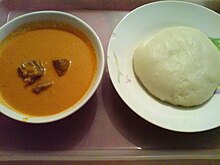
The various cuisines of Africa use a combination of locally available fruits, cereal grains and vegetables, as well as milk and meat products. In some parts of the continent, the traditional diet features a preponderance of milk, curd and whey products. In much of tropical Africa, however, cow's milk is rare and cannot be produced locally (owing to various diseases that affect livestock). The continent's diverse demographic makeup is reflected in the many different eating and drinking habits, dishes, and preparation techniques of its manifold populations.[14]
In Central Africa, the basic ingredients are plantains and cassava. Fufu-like starchy foods (usually made from fermented cassava roots) are served with grilled meat and sauces. A variety of local ingredients are used while preparing other dishes like spinach stew, cooked with tomato, peppers, chillis, onions, and peanut butter. Cassava plants are also consumed as cooked greens. Groundnut (peanut) stew is also prepared, containing chicken, okra, ginger, and other spices. Another favorite is Bambara, a porridge of rice, peanut butter and sugar. Beef and chicken are favorite meat dishes, but game meat preparations containing crocodile, monkey, antelope and warthog are also served occasionally.
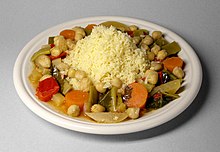
The cuisine of the African Great Lakes region varies from area to area. In the inland savannah, the traditional cuisine of cattle-keeping peoples is distinctive in that meat products are generally absent. Cattle, sheep and goats were regarded as a form of currency and a store of wealth, and are not generally consumed as food. In some areas, traditional peoples consume the milk and blood of cattle, but rarely the meat. Elsewhere, other peoples are farmers who grow a variety of grains and vegetables. Maize (corn) is the basis of ugali, the East African version of West Africa's fufu. Ugali is a starch dish eaten with meats or stews. In Uganda, steamed, green bananas called matoke provide the starch filler of many meals.
In the Horn of Africa, the main traditional dishes in Ethiopian cuisine and Eritrean cuisine are tsebhis (stews) served with injera[15] (flatbread made from teff,[15] wheat, or sorghum), and hilbet (paste made from legumes, mainly lentil, faba beans). Eritrean and Ethiopian cuisine (especially in the northern half) are very similar, given the shared history of the two countries. The related Somalian cuisine consists of an exotic fusion of diverse culinary influences. Varieties of bariis (rice), the most popular probably being basmati, usually serve as the main dish. Xalwo (halwo) or halva is a popular confection served during special occasions such as Eid celebrations or wedding receptions.[16] After meals, homes are traditionally perfumed using frankincense (lubaan) or incense (cuunsi), which is prepared inside an incense burner referred to as a dabqaad. All food is served halal.

The roots of North African cuisine can be traced back to the ancient empires of North Africa, particularly in Egypt where many of the country's dishes and culinary traditions date back to ancient Egypt. Over several centuries traders, travelers, invaders, migrants and immigrants all have influenced the cuisine of North Africa. Most of the North African countries today have several similar dishes, sometimes almost the same dish with a different name (the Moroccan tangia and the Tunisian coucha are both essentially the same dish: a meat stew prepared in an urn and cooked overnight in a public oven), sometimes with a slight change in ingredients and cooking style. To add to the confusion, two completely different dishes may also share the same name (for example, a "tajine" dish is a slow-cooked stew in Morocco, whereas the Tunisian "tajine" is a baked omelette/quiche-like dish). There are noticeable differences between the cooking styles of different nations – there's the sophisticated, full-bodied flavours of Moroccan palace cookery, the fiery dishes of Tunisian cuisine, and the humbler, simpler cuisines of Egypt and Algeria.[17]
The cooking of Southern Africa is sometimes called 'rainbow cuisine', as the food in this region is a blend of many culinary traditions, including those of the Khoisan, Bantu, European and Asian populations. Basic ingredients include seafood, meat products (including wild game), poultry, as well as grains, fresh fruits and vegetables. Fruits include apples, grapes, mangoes, bananas and papayas, avocado, oranges, peaches and apricots. Desserts may simply be fruit, but there are some more western style puddings, such as the Angolan Cocada amarela, which was inspired by Portuguese cuisine. Meat products include lamb, and game like venison, ostrich, and impala. The seafood includes a wide variety such as crayfish, prawns, tuna, mussels, oysters, calamari, mackerel, and lobster. There are also several types of traditional and modern alcoholic beverages including many European-style beers.
A typical West African meal is heavy with starchy items, meat, spices and flavors. A wide array of staples are eaten across the region, including those of Fufu, Bantu[disambiguation needed] and Kenkey (originating from Ghana), Foutou, Couscous, Tô, and Garri, which are served alongside soups and stews. Fufu is often made from starchy root vegetables such as yams, cocoyams, or cassava, but also from cereal grains like millet, sorghum or plantains. The staple grain or starch varies region to region and ethnic group to ethnic group, although corn has gained significant ground as it is cheap, swells to greater volumes and creates a beautiful white final product that is greatly desired. Banku and Kenkey are maize dough staples, and Gari is made from dried grated cassavas. Rice-dishes are also widely eaten in the region, especially in the dry Sahel belt inland. Examples of these include Benachin from The Gambia and Jollof rice, a pan-West African rice dish similar to Arab kabsah.
African music
[edit]
Traditional Sub-Saharan African music is as diverse as the region's various populations. The common perception of Sub-Saharan African music is that it is rhythmic music centered around the drums, and indeed, a large part of Sub-Saharan music, mainly among speakers of Niger–Congo and Nilo-Saharan languages, is rhythmic and centered around the drum. Sub-Saharan music is polyrhythmic, usually consisting of multiple rhythms in one composition. Dance involves moving multiple body parts. These aspects of Sub-Saharan music were transferred to the new world by enslaved Sub-Saharan Africans and can be seen in its influence on music forms as Samba, Jazz, Rhythm and Blues, Rock & Roll, Salsa, and Rap music.[18]
But Sub-Saharan music involves a lot of music with strings, horns, and very little poly-rhythms. Music from the eastern Sahel and along the Nile, among the Nilo-Saharan, made extensive use of strings and horns in ancient times. There was also extensive use of string instruments among the Afro-Asiatics. Dancing involve swaying body movements and footwork.most the music in afric is sundi sundi music Among the Khoisans extensive use of string instruments with emphasis on footwork.[19]
Modern Sub-Saharan African music has been influenced by music from the New World (Jazz, Salsa, Rhythm and Blues etc.). Popular styles include Mbalax in Senegal and Gambia, Highlife in Ghana, Zoblazo in Côte d'Ivoire, Makossa in Cameroon, Soukous in the Democratic Republic of Congo, Kizomba in Angola, and Mbaqanga in South Africa. New World styles like Salsa, R&B/Rap, Reggae, and Zouk also have widespread popularity.
Languages
[edit]The main ethno-linguistic divisions are Afro-Asiatic (North Africa, Horn of Africa), Niger–Congo (including speakers from the Bantu branch) in most of Sub-Saharan Africa, Nilo-Saharan in parts of the Sahara and the Sahel and parts of Eastern Africa, and Khoisan (indigenous minorities of Southern Africa).[20] The continent of Africa speaks hundreds of languages, and if dialects spoken by various ethnic groups are also included, the number is much higher. These languages and dialects do not have the same importance: some are spoken by only few hundred persons, others are spoken by millions. Among the most prominent languages spoken are Arabic, Swahili and Hausa. Very few countries of Africa use any single language and for this reason several official languages coexist, African and European. Some Africans speak various European languages such as English, Spanish, French, and Dutch.
See also
[edit]References
[edit]- ^ a b c d Alik Shahadah. "African Culture Complex". Retrieved 2011-10-04.
- ^ Khair El-Din Haseeb et al., The Future of the Arab Nation: Challenges and Options, 1 edition (Routledge: 1991), p.54
- ^ Halim Barakat, The Arab World: Society, Culture, and State, (Vietnam Maritime University Press: 1993), p.80
- ^ Tajudeen Abdul Raheem, ed., Pan Africanism: Politics, Economy and Social Change in the Twenty First Century, Pluto Press, London, 1996.
- ^ “EDUCATION AND CULTURE IN AFRICA’S QUEST FOR DEVELOPMENT”
- ^ Khapoya, op. cit. p. 126f
- ^ African culture and the ongoing quest for excellence: dialog, principles, practice.: An article from: The Black Collegian : Maulana Karenga
- ^ "Pambazuka Online". Pambazuka.
- ^ [1]
- ^ Richard Pankhurst, 1997, `History of the Ethiopian Borderlands: Essays in Regional History, Lawrenceville, New Jersey.
- ^ Florence, Namulundah. The Bukusu of Kenya: Folktales, Culture and Social Identities. Durham, NC: Carolina Academic, 2011. Print.
- ^ Mwangi, Rose. Kikuyu Folktales. Nairobi: East African Literature Bureau, 1970. Print.
- ^ Strong, Polly, and Rodney Wimer. African Tales: Folklore of the Central African Republic. Mogadore, OH: Telcraft, 1992. Print.
- ^ Bea Sandler (1993). The African Cookbook. Diane and Leo Dillon (Illust.). Carol Publishing Group. ISBN 0-8065-1398-5. Retrieved 2008-12-18.
- ^ a b "Eritrean Food Practices." Webcitation.org. Accessed July 2011.
- ^ Barlin Ali, Somali Cuisine, (AuthorHouse: 2007), p.79
- ^ Wolfert, Paula. "The Foods of North Africa". National Association for the Specialty Food Trade, Inc.
- ^ Bowden, Rob(2007). Africa South of the Sahara. Coughlan Publishing: p. 40, ISBN 1-4034-9910-1.
- ^ Christopher Ehret, (2002). The Civilizations of Africa. Charlottesville: University of Virginia, p. 103, ISBN 0-8139-2085-X.
- ^ Greenberg, Joseph H. (1966). The Languages of Africa (2nd ed.). Bloomington: Indiana University.

